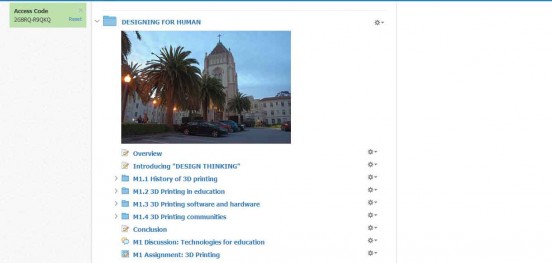Module One Description:
According to Kolko (2012), our society is plagued with many injustices and problems that are so large in scale that students might find it daunting to try to find solutions to them. These problems are referred to as “wicked problems.” How to facilitate our students to solve these problems became a challenge for us educators. The term of
Design Thinking is increasingly being used to mean the human-centered “open” problem solving process.
You are already familiar with many traditional prototyping methods, such as paper prototyping, physical prototyping, and computer software aid prototyping. This module will challenge you with 3D printing as a prototyping method.
Student Outcomes:
- Learn and become familiar with the Stanford’s d.School Design Thinking method;
- Learn how to facilitate a Design Thinking problem solving session;
- Able to use different methods to create prototypes;
- Learn 3D printing basics including hardware and software;
- Become familiar with 3D printing communities;
- Be able to take advantage of open source 3D printing models to facilitate classroom activities.
Module One Reading:
Module One Activities:
- In this class, we will follow Stanford’s d.School method, using the five models to solve a problem: Ineffective layout of our computer lab. We will explore different familiar prototyping methods such as sticky note paper prototype, Lego physical prototype, and introduce a new prototyping method— the 3D printed prototype.
(For online only course, you will be divided into groups of 3, work with your team members. After the group complete the assignment, the group will produce a presentation movies to share with the class. In the movie, you will present all five steps of the Design Thinking problem solving process, and share with the class of their final prototype. For on-site class, you will complete the activity in class, then invite the entire class to test the prototype.)
- Assignment: In module one we will explore 3D printing technology. Familiar yourself with one of the 3D designing/modeling tools. Test print items on our 3D printer. The home work for this module is to print one 3D prototype that you might use in one of your teaching classes or training session.
For example, if you are teaching 2D or 3D shapes, you can work out 3D printed shapes in your curriculum, if you are teaching chemistry, maybe you can print a small molecules, body parts for nursing course, logos for design lessons. There are endless possibilities.
Module One Discussion:
Please read http://www.ed.gov/oii-news/use-technology-teaching-and-learning
Compare your idea of how technology should be used in education to how it is actually used in your school. Critique from your own perspective as a teacher or a student.
- Which technologies are being used at your school or university? How are they being used? By whom?
- Do these technologies contribute and help teachers?
- Do these technologies benefit students?
- How would students use the technologies at school AND out of the classroom (remember some students may not have access at home)? Explain your response.
- If you were to design a course, what technologies would you use?

